London School of Science: Business Strategy Analysis Report (MN6008)
VerifiedAdded on 2022/09/27
|16
|4568
|23
Report
AI Summary
This report, prepared by a student, analyzes key strategic business analysis tools, including TOWS, VRIO, and Porter's Diamond. The report begins with an executive summary highlighting the importance of these tools in assessing both internal and external business environments. The introduction emphasizes the significance of strategic thinking and introduces the three main tools under consideration. The TOWS matrix is examined, detailing its usage, benefits, and challenges, with examples. The VRIO framework is then discussed, focusing on its application in evaluating internal business resources. The report delves into the components of VRIO (Value, Rarity, Imitability, and Organization), providing insights into how companies can achieve a competitive advantage. The report also mentions the Porter Diamond model. Finally, the report concludes with a discussion of the challenges associated with applying these frameworks and provides the student's insights and reflections throughout the analysis. This valuable resource is available on Desklib, a platform offering past papers and study tools for students.
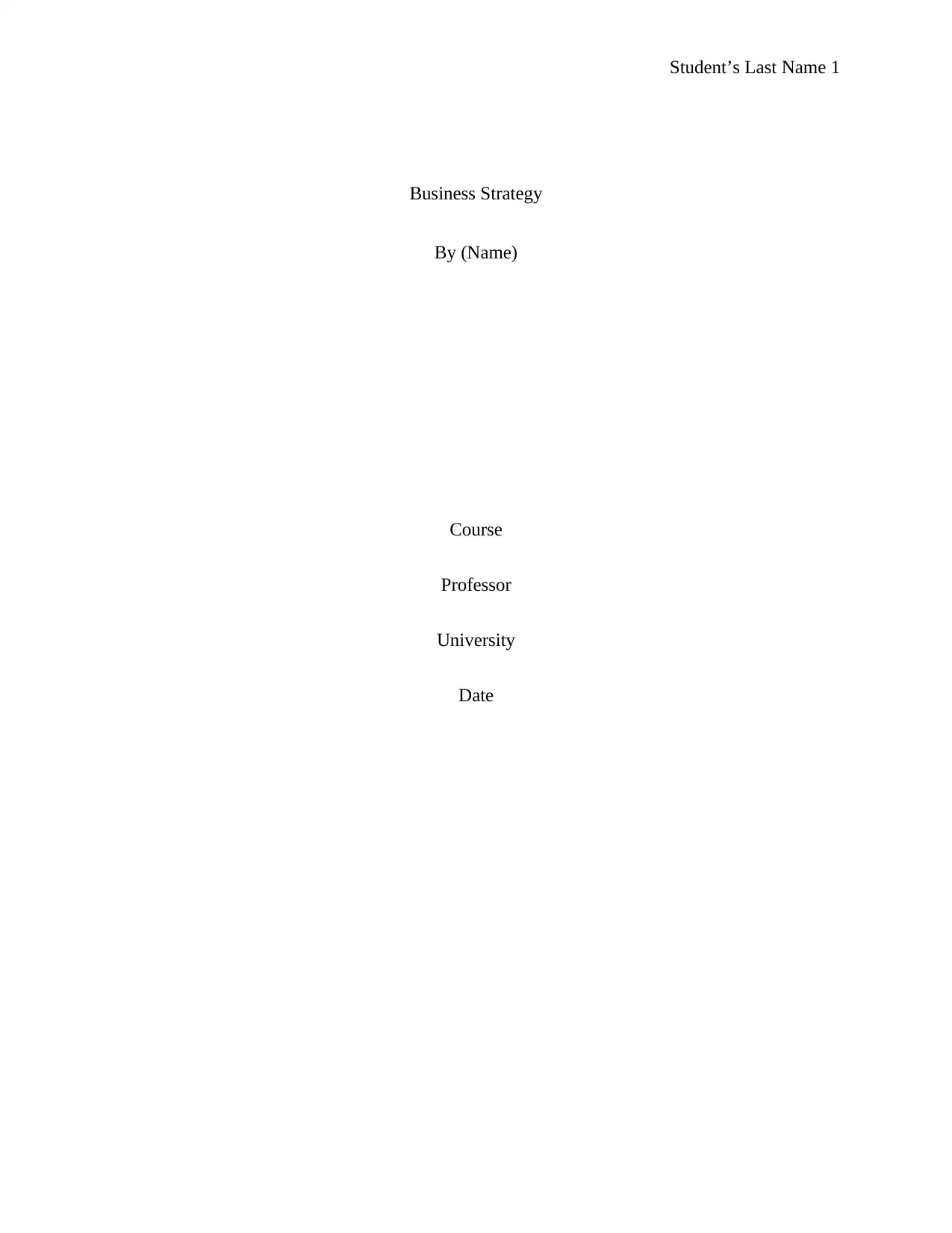
Student’s Last Name 1
Business Strategy
By (Name)
Course
Professor
University
Date
Business Strategy
By (Name)
Course
Professor
University
Date
Paraphrase This Document
Need a fresh take? Get an instant paraphrase of this document with our AI Paraphraser
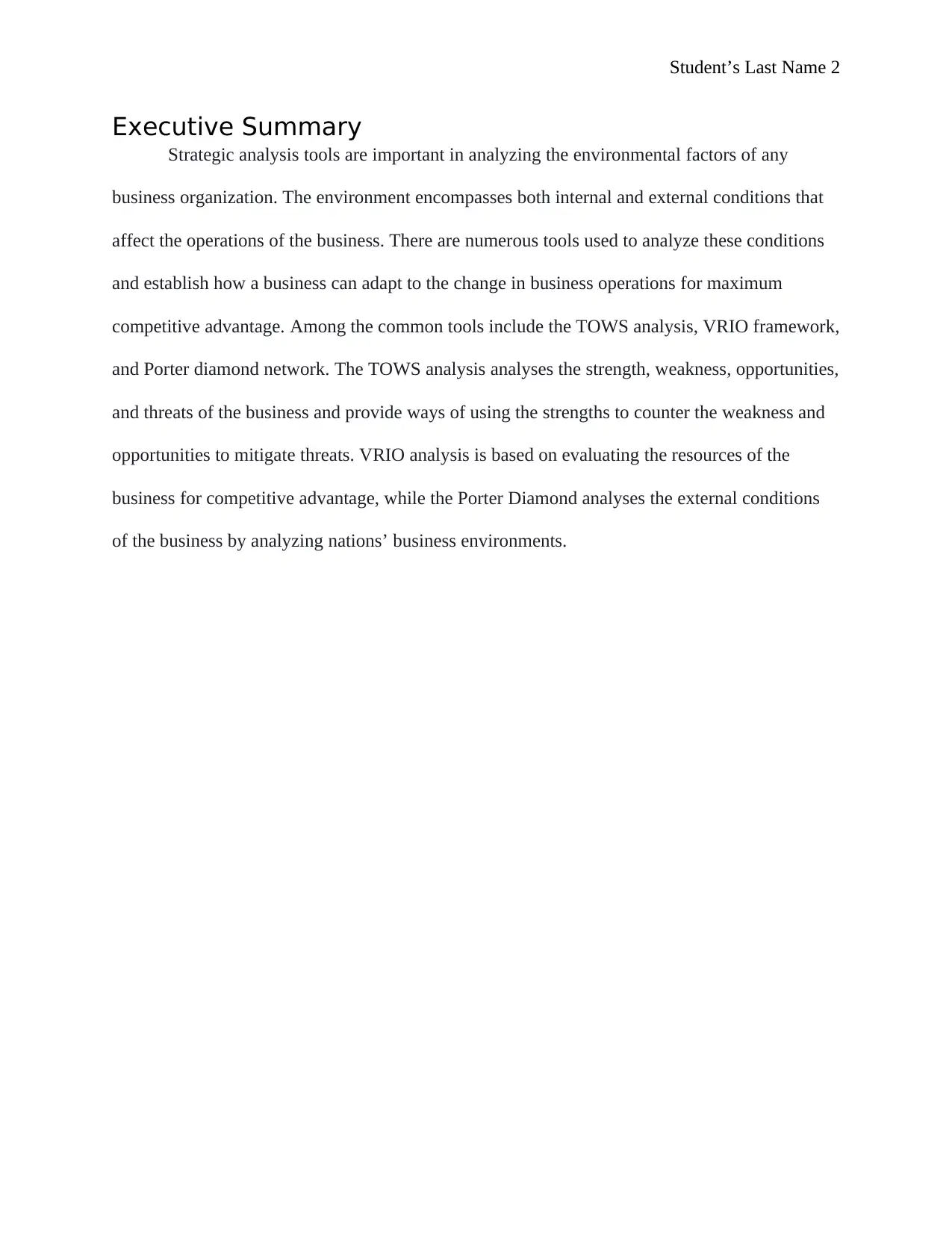
Student’s Last Name 2
Executive Summary
Strategic analysis tools are important in analyzing the environmental factors of any
business organization. The environment encompasses both internal and external conditions that
affect the operations of the business. There are numerous tools used to analyze these conditions
and establish how a business can adapt to the change in business operations for maximum
competitive advantage. Among the common tools include the TOWS analysis, VRIO framework,
and Porter diamond network. The TOWS analysis analyses the strength, weakness, opportunities,
and threats of the business and provide ways of using the strengths to counter the weakness and
opportunities to mitigate threats. VRIO analysis is based on evaluating the resources of the
business for competitive advantage, while the Porter Diamond analyses the external conditions
of the business by analyzing nations’ business environments.
Executive Summary
Strategic analysis tools are important in analyzing the environmental factors of any
business organization. The environment encompasses both internal and external conditions that
affect the operations of the business. There are numerous tools used to analyze these conditions
and establish how a business can adapt to the change in business operations for maximum
competitive advantage. Among the common tools include the TOWS analysis, VRIO framework,
and Porter diamond network. The TOWS analysis analyses the strength, weakness, opportunities,
and threats of the business and provide ways of using the strengths to counter the weakness and
opportunities to mitigate threats. VRIO analysis is based on evaluating the resources of the
business for competitive advantage, while the Porter Diamond analyses the external conditions
of the business by analyzing nations’ business environments.
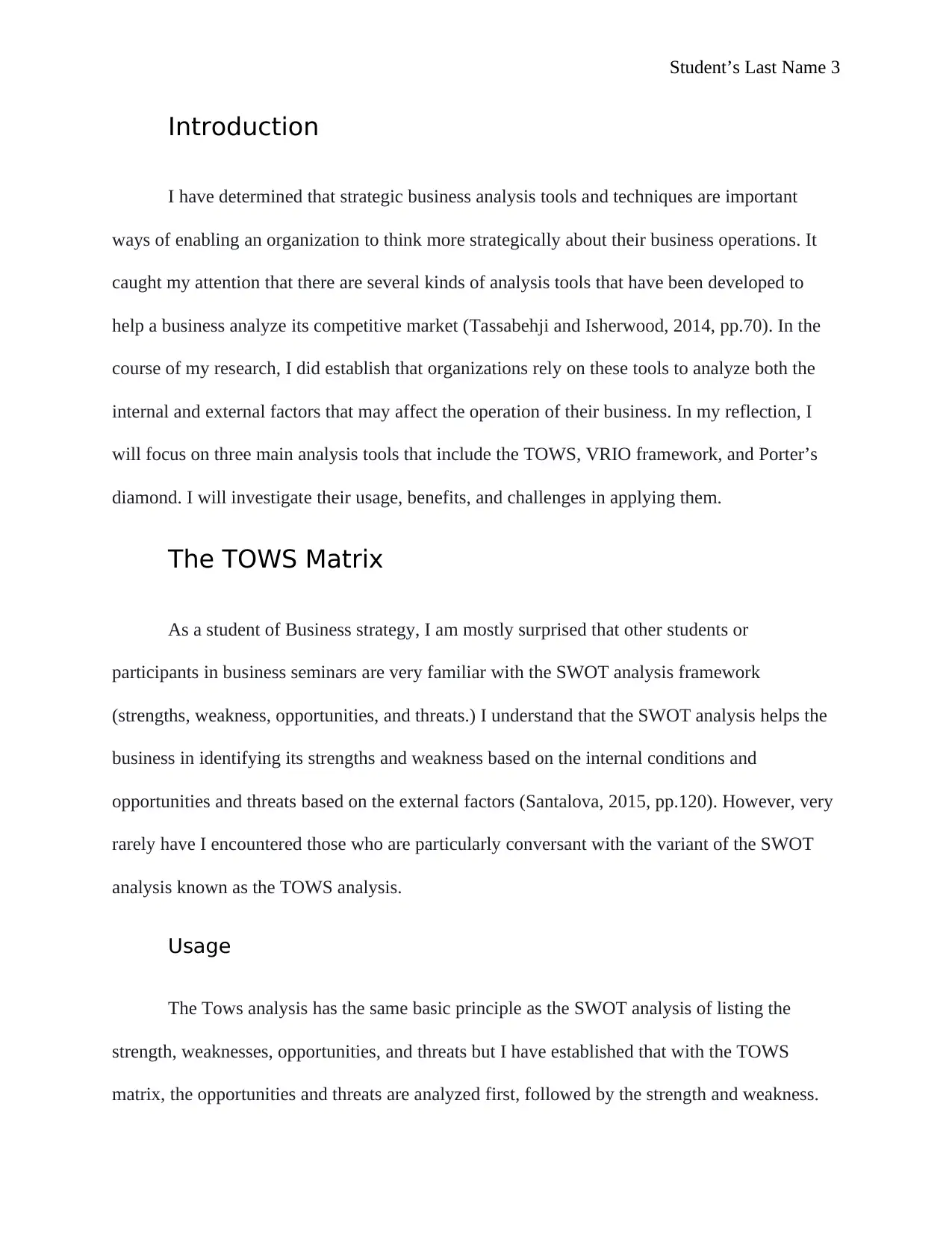
Student’s Last Name 3
Introduction
I have determined that strategic business analysis tools and techniques are important
ways of enabling an organization to think more strategically about their business operations. It
caught my attention that there are several kinds of analysis tools that have been developed to
help a business analyze its competitive market (Tassabehji and Isherwood, 2014, pp.70). In the
course of my research, I did establish that organizations rely on these tools to analyze both the
internal and external factors that may affect the operation of their business. In my reflection, I
will focus on three main analysis tools that include the TOWS, VRIO framework, and Porter’s
diamond. I will investigate their usage, benefits, and challenges in applying them.
The TOWS Matrix
As a student of Business strategy, I am mostly surprised that other students or
participants in business seminars are very familiar with the SWOT analysis framework
(strengths, weakness, opportunities, and threats.) I understand that the SWOT analysis helps the
business in identifying its strengths and weakness based on the internal conditions and
opportunities and threats based on the external factors (Santalova, 2015, pp.120). However, very
rarely have I encountered those who are particularly conversant with the variant of the SWOT
analysis known as the TOWS analysis.
Usage
The Tows analysis has the same basic principle as the SWOT analysis of listing the
strength, weaknesses, opportunities, and threats but I have established that with the TOWS
matrix, the opportunities and threats are analyzed first, followed by the strength and weakness.
Introduction
I have determined that strategic business analysis tools and techniques are important
ways of enabling an organization to think more strategically about their business operations. It
caught my attention that there are several kinds of analysis tools that have been developed to
help a business analyze its competitive market (Tassabehji and Isherwood, 2014, pp.70). In the
course of my research, I did establish that organizations rely on these tools to analyze both the
internal and external factors that may affect the operation of their business. In my reflection, I
will focus on three main analysis tools that include the TOWS, VRIO framework, and Porter’s
diamond. I will investigate their usage, benefits, and challenges in applying them.
The TOWS Matrix
As a student of Business strategy, I am mostly surprised that other students or
participants in business seminars are very familiar with the SWOT analysis framework
(strengths, weakness, opportunities, and threats.) I understand that the SWOT analysis helps the
business in identifying its strengths and weakness based on the internal conditions and
opportunities and threats based on the external factors (Santalova, 2015, pp.120). However, very
rarely have I encountered those who are particularly conversant with the variant of the SWOT
analysis known as the TOWS analysis.
Usage
The Tows analysis has the same basic principle as the SWOT analysis of listing the
strength, weaknesses, opportunities, and threats but I have established that with the TOWS
matrix, the opportunities and threats are analyzed first, followed by the strength and weakness.
⊘ This is a preview!⊘
Do you want full access?
Subscribe today to unlock all pages.

Trusted by 1+ million students worldwide
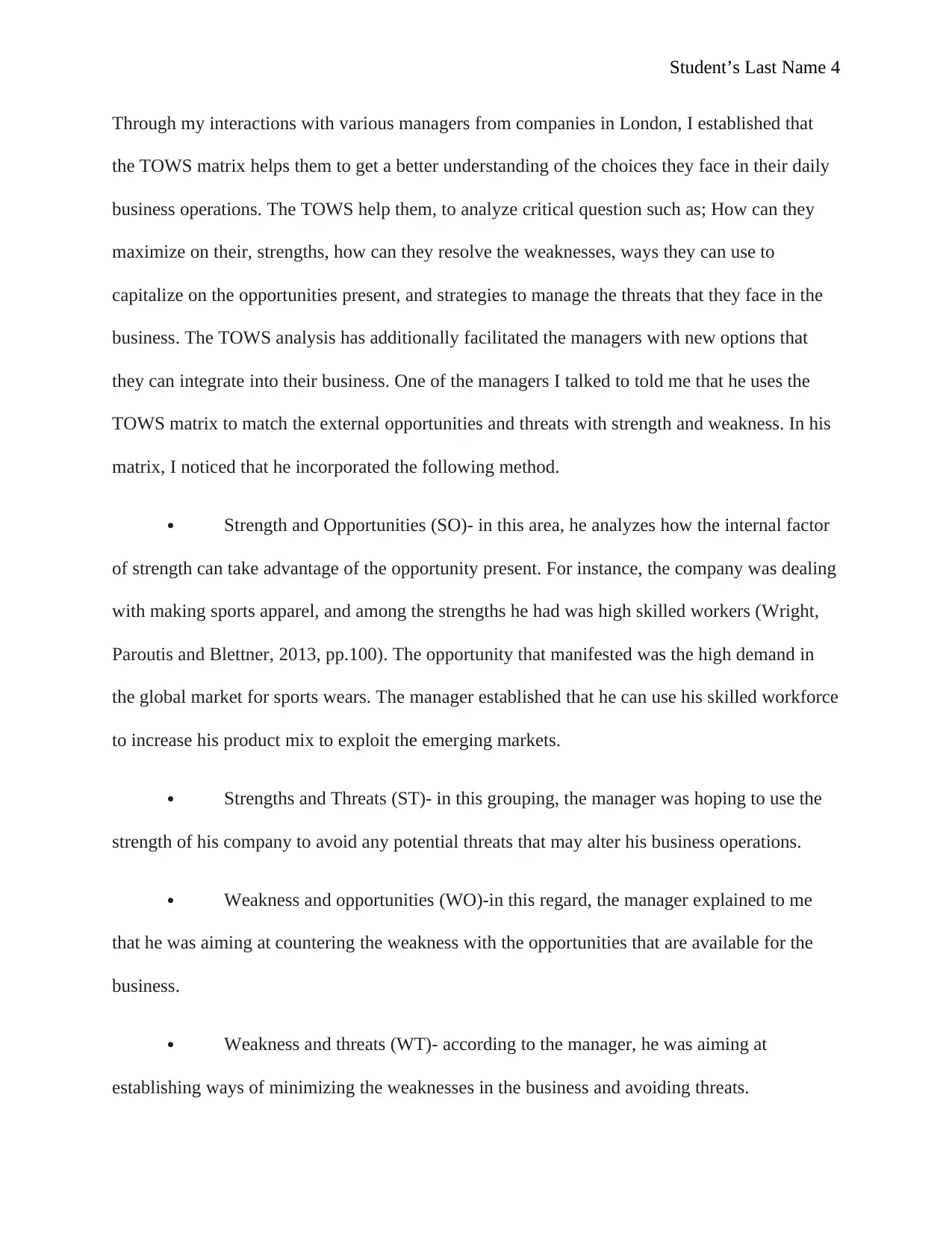
Student’s Last Name 4
Through my interactions with various managers from companies in London, I established that
the TOWS matrix helps them to get a better understanding of the choices they face in their daily
business operations. The TOWS help them, to analyze critical question such as; How can they
maximize on their, strengths, how can they resolve the weaknesses, ways they can use to
capitalize on the opportunities present, and strategies to manage the threats that they face in the
business. The TOWS analysis has additionally facilitated the managers with new options that
they can integrate into their business. One of the managers I talked to told me that he uses the
TOWS matrix to match the external opportunities and threats with strength and weakness. In his
matrix, I noticed that he incorporated the following method.
Strength and Opportunities (SO)- in this area, he analyzes how the internal factor
of strength can take advantage of the opportunity present. For instance, the company was dealing
with making sports apparel, and among the strengths he had was high skilled workers (Wright,
Paroutis and Blettner, 2013, pp.100). The opportunity that manifested was the high demand in
the global market for sports wears. The manager established that he can use his skilled workforce
to increase his product mix to exploit the emerging markets.
Strengths and Threats (ST)- in this grouping, the manager was hoping to use the
strength of his company to avoid any potential threats that may alter his business operations.
Weakness and opportunities (WO)-in this regard, the manager explained to me
that he was aiming at countering the weakness with the opportunities that are available for the
business.
Weakness and threats (WT)- according to the manager, he was aiming at
establishing ways of minimizing the weaknesses in the business and avoiding threats.
Through my interactions with various managers from companies in London, I established that
the TOWS matrix helps them to get a better understanding of the choices they face in their daily
business operations. The TOWS help them, to analyze critical question such as; How can they
maximize on their, strengths, how can they resolve the weaknesses, ways they can use to
capitalize on the opportunities present, and strategies to manage the threats that they face in the
business. The TOWS analysis has additionally facilitated the managers with new options that
they can integrate into their business. One of the managers I talked to told me that he uses the
TOWS matrix to match the external opportunities and threats with strength and weakness. In his
matrix, I noticed that he incorporated the following method.
Strength and Opportunities (SO)- in this area, he analyzes how the internal factor
of strength can take advantage of the opportunity present. For instance, the company was dealing
with making sports apparel, and among the strengths he had was high skilled workers (Wright,
Paroutis and Blettner, 2013, pp.100). The opportunity that manifested was the high demand in
the global market for sports wears. The manager established that he can use his skilled workforce
to increase his product mix to exploit the emerging markets.
Strengths and Threats (ST)- in this grouping, the manager was hoping to use the
strength of his company to avoid any potential threats that may alter his business operations.
Weakness and opportunities (WO)-in this regard, the manager explained to me
that he was aiming at countering the weakness with the opportunities that are available for the
business.
Weakness and threats (WT)- according to the manager, he was aiming at
establishing ways of minimizing the weaknesses in the business and avoiding threats.
Paraphrase This Document
Need a fresh take? Get an instant paraphrase of this document with our AI Paraphraser
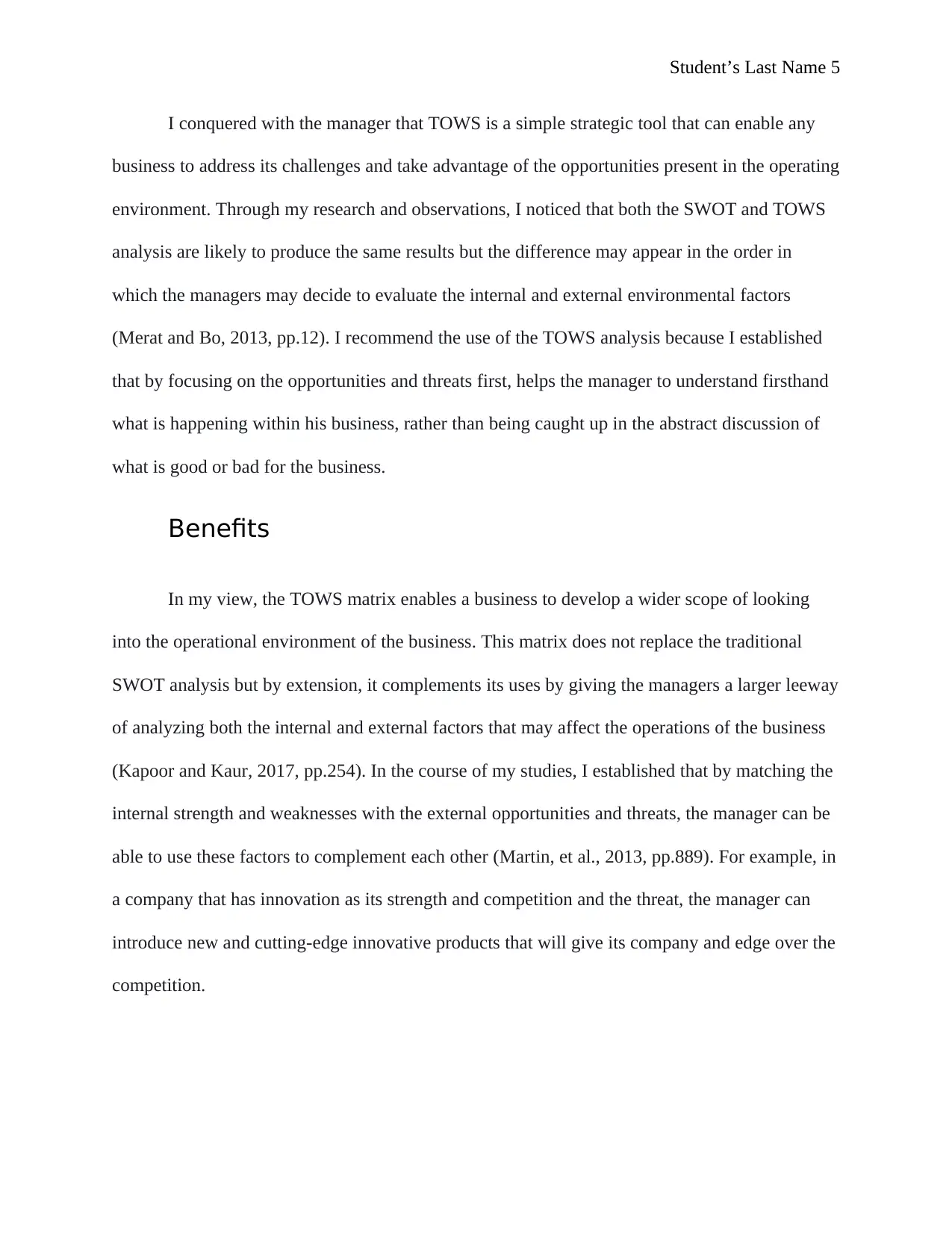
Student’s Last Name 5
I conquered with the manager that TOWS is a simple strategic tool that can enable any
business to address its challenges and take advantage of the opportunities present in the operating
environment. Through my research and observations, I noticed that both the SWOT and TOWS
analysis are likely to produce the same results but the difference may appear in the order in
which the managers may decide to evaluate the internal and external environmental factors
(Merat and Bo, 2013, pp.12). I recommend the use of the TOWS analysis because I established
that by focusing on the opportunities and threats first, helps the manager to understand firsthand
what is happening within his business, rather than being caught up in the abstract discussion of
what is good or bad for the business.
Benefits
In my view, the TOWS matrix enables a business to develop a wider scope of looking
into the operational environment of the business. This matrix does not replace the traditional
SWOT analysis but by extension, it complements its uses by giving the managers a larger leeway
of analyzing both the internal and external factors that may affect the operations of the business
(Kapoor and Kaur, 2017, pp.254). In the course of my studies, I established that by matching the
internal strength and weaknesses with the external opportunities and threats, the manager can be
able to use these factors to complement each other (Martin, et al., 2013, pp.889). For example, in
a company that has innovation as its strength and competition and the threat, the manager can
introduce new and cutting-edge innovative products that will give its company and edge over the
competition.
I conquered with the manager that TOWS is a simple strategic tool that can enable any
business to address its challenges and take advantage of the opportunities present in the operating
environment. Through my research and observations, I noticed that both the SWOT and TOWS
analysis are likely to produce the same results but the difference may appear in the order in
which the managers may decide to evaluate the internal and external environmental factors
(Merat and Bo, 2013, pp.12). I recommend the use of the TOWS analysis because I established
that by focusing on the opportunities and threats first, helps the manager to understand firsthand
what is happening within his business, rather than being caught up in the abstract discussion of
what is good or bad for the business.
Benefits
In my view, the TOWS matrix enables a business to develop a wider scope of looking
into the operational environment of the business. This matrix does not replace the traditional
SWOT analysis but by extension, it complements its uses by giving the managers a larger leeway
of analyzing both the internal and external factors that may affect the operations of the business
(Kapoor and Kaur, 2017, pp.254). In the course of my studies, I established that by matching the
internal strength and weaknesses with the external opportunities and threats, the manager can be
able to use these factors to complement each other (Martin, et al., 2013, pp.889). For example, in
a company that has innovation as its strength and competition and the threat, the manager can
introduce new and cutting-edge innovative products that will give its company and edge over the
competition.
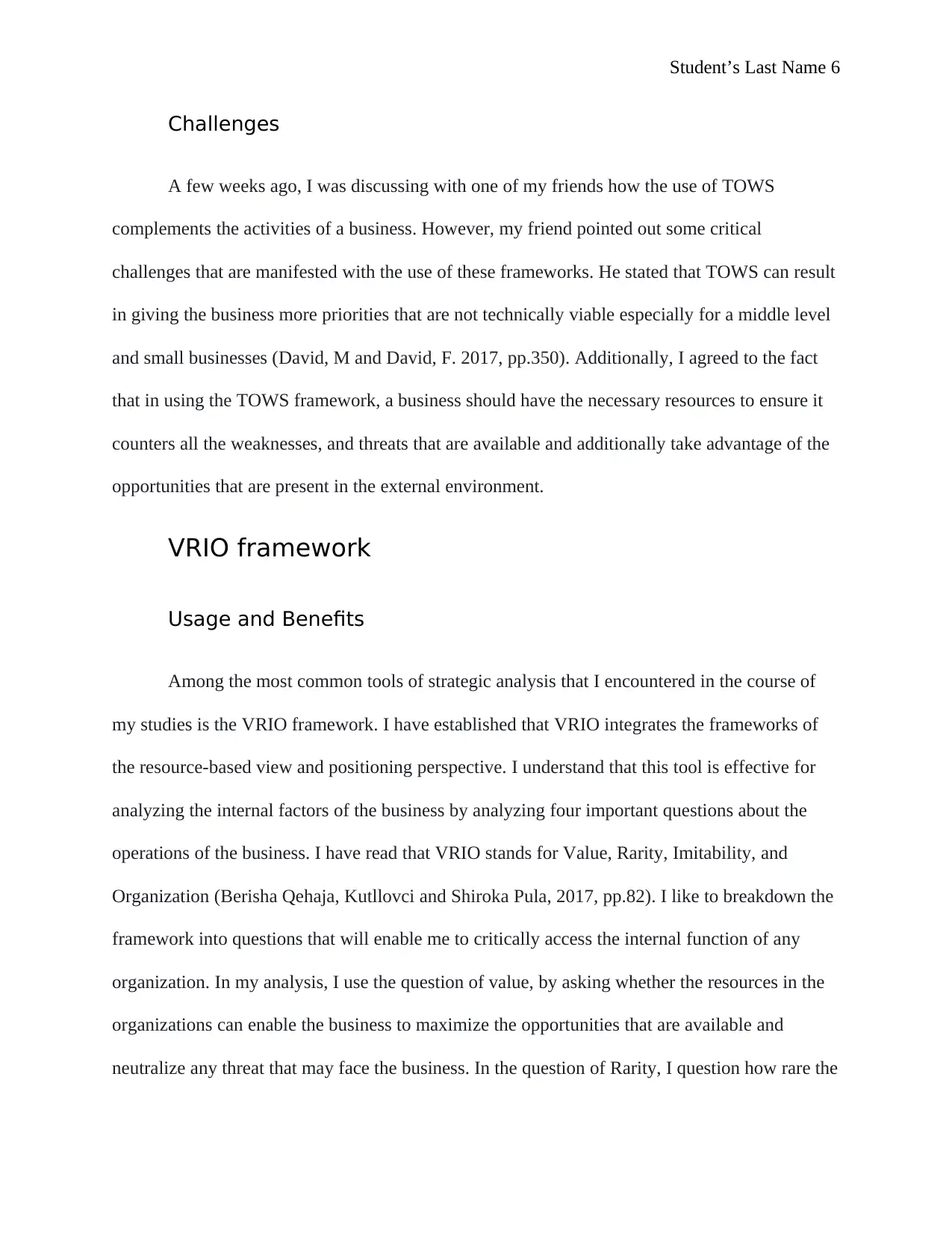
Student’s Last Name 6
Challenges
A few weeks ago, I was discussing with one of my friends how the use of TOWS
complements the activities of a business. However, my friend pointed out some critical
challenges that are manifested with the use of these frameworks. He stated that TOWS can result
in giving the business more priorities that are not technically viable especially for a middle level
and small businesses (David, M and David, F. 2017, pp.350). Additionally, I agreed to the fact
that in using the TOWS framework, a business should have the necessary resources to ensure it
counters all the weaknesses, and threats that are available and additionally take advantage of the
opportunities that are present in the external environment.
VRIO framework
Usage and Benefits
Among the most common tools of strategic analysis that I encountered in the course of
my studies is the VRIO framework. I have established that VRIO integrates the frameworks of
the resource-based view and positioning perspective. I understand that this tool is effective for
analyzing the internal factors of the business by analyzing four important questions about the
operations of the business. I have read that VRIO stands for Value, Rarity, Imitability, and
Organization (Berisha Qehaja, Kutllovci and Shiroka Pula, 2017, pp.82). I like to breakdown the
framework into questions that will enable me to critically access the internal function of any
organization. In my analysis, I use the question of value, by asking whether the resources in the
organizations can enable the business to maximize the opportunities that are available and
neutralize any threat that may face the business. In the question of Rarity, I question how rare the
Challenges
A few weeks ago, I was discussing with one of my friends how the use of TOWS
complements the activities of a business. However, my friend pointed out some critical
challenges that are manifested with the use of these frameworks. He stated that TOWS can result
in giving the business more priorities that are not technically viable especially for a middle level
and small businesses (David, M and David, F. 2017, pp.350). Additionally, I agreed to the fact
that in using the TOWS framework, a business should have the necessary resources to ensure it
counters all the weaknesses, and threats that are available and additionally take advantage of the
opportunities that are present in the external environment.
VRIO framework
Usage and Benefits
Among the most common tools of strategic analysis that I encountered in the course of
my studies is the VRIO framework. I have established that VRIO integrates the frameworks of
the resource-based view and positioning perspective. I understand that this tool is effective for
analyzing the internal factors of the business by analyzing four important questions about the
operations of the business. I have read that VRIO stands for Value, Rarity, Imitability, and
Organization (Berisha Qehaja, Kutllovci and Shiroka Pula, 2017, pp.82). I like to breakdown the
framework into questions that will enable me to critically access the internal function of any
organization. In my analysis, I use the question of value, by asking whether the resources in the
organizations can enable the business to maximize the opportunities that are available and
neutralize any threat that may face the business. In the question of Rarity, I question how rare the
⊘ This is a preview!⊘
Do you want full access?
Subscribe today to unlock all pages.

Trusted by 1+ million students worldwide
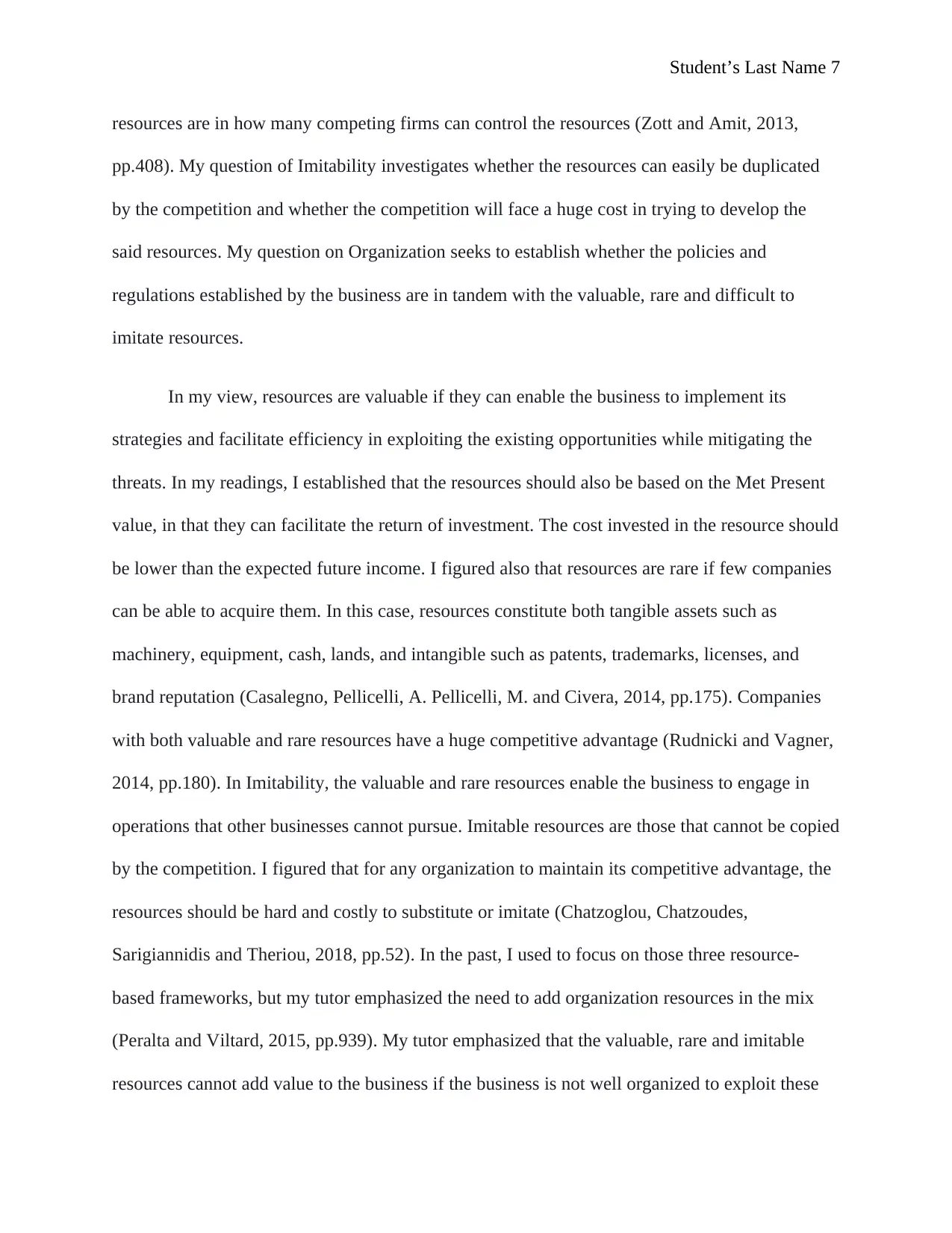
Student’s Last Name 7
resources are in how many competing firms can control the resources (Zott and Amit, 2013,
pp.408). My question of Imitability investigates whether the resources can easily be duplicated
by the competition and whether the competition will face a huge cost in trying to develop the
said resources. My question on Organization seeks to establish whether the policies and
regulations established by the business are in tandem with the valuable, rare and difficult to
imitate resources.
In my view, resources are valuable if they can enable the business to implement its
strategies and facilitate efficiency in exploiting the existing opportunities while mitigating the
threats. In my readings, I established that the resources should also be based on the Met Present
value, in that they can facilitate the return of investment. The cost invested in the resource should
be lower than the expected future income. I figured also that resources are rare if few companies
can be able to acquire them. In this case, resources constitute both tangible assets such as
machinery, equipment, cash, lands, and intangible such as patents, trademarks, licenses, and
brand reputation (Casalegno, Pellicelli, A. Pellicelli, M. and Civera, 2014, pp.175). Companies
with both valuable and rare resources have a huge competitive advantage (Rudnicki and Vagner,
2014, pp.180). In Imitability, the valuable and rare resources enable the business to engage in
operations that other businesses cannot pursue. Imitable resources are those that cannot be copied
by the competition. I figured that for any organization to maintain its competitive advantage, the
resources should be hard and costly to substitute or imitate (Chatzoglou, Chatzoudes,
Sarigiannidis and Theriou, 2018, pp.52). In the past, I used to focus on those three resource-
based frameworks, but my tutor emphasized the need to add organization resources in the mix
(Peralta and Viltard, 2015, pp.939). My tutor emphasized that the valuable, rare and imitable
resources cannot add value to the business if the business is not well organized to exploit these
resources are in how many competing firms can control the resources (Zott and Amit, 2013,
pp.408). My question of Imitability investigates whether the resources can easily be duplicated
by the competition and whether the competition will face a huge cost in trying to develop the
said resources. My question on Organization seeks to establish whether the policies and
regulations established by the business are in tandem with the valuable, rare and difficult to
imitate resources.
In my view, resources are valuable if they can enable the business to implement its
strategies and facilitate efficiency in exploiting the existing opportunities while mitigating the
threats. In my readings, I established that the resources should also be based on the Met Present
value, in that they can facilitate the return of investment. The cost invested in the resource should
be lower than the expected future income. I figured also that resources are rare if few companies
can be able to acquire them. In this case, resources constitute both tangible assets such as
machinery, equipment, cash, lands, and intangible such as patents, trademarks, licenses, and
brand reputation (Casalegno, Pellicelli, A. Pellicelli, M. and Civera, 2014, pp.175). Companies
with both valuable and rare resources have a huge competitive advantage (Rudnicki and Vagner,
2014, pp.180). In Imitability, the valuable and rare resources enable the business to engage in
operations that other businesses cannot pursue. Imitable resources are those that cannot be copied
by the competition. I figured that for any organization to maintain its competitive advantage, the
resources should be hard and costly to substitute or imitate (Chatzoglou, Chatzoudes,
Sarigiannidis and Theriou, 2018, pp.52). In the past, I used to focus on those three resource-
based frameworks, but my tutor emphasized the need to add organization resources in the mix
(Peralta and Viltard, 2015, pp.939). My tutor emphasized that the valuable, rare and imitable
resources cannot add value to the business if the business is not well organized to exploit these
Paraphrase This Document
Need a fresh take? Get an instant paraphrase of this document with our AI Paraphraser
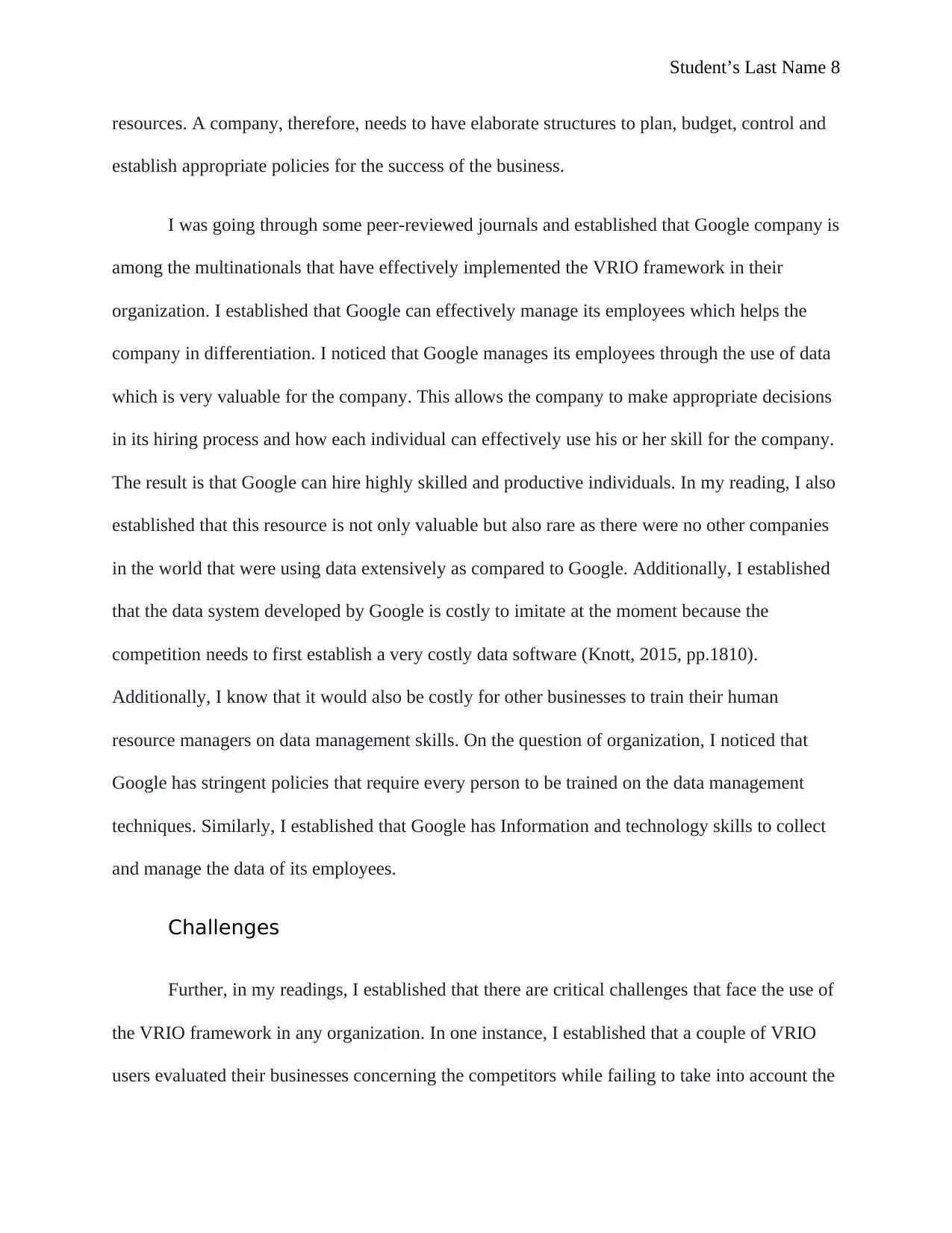
Student’s Last Name 8
resources. A company, therefore, needs to have elaborate structures to plan, budget, control and
establish appropriate policies for the success of the business.
I was going through some peer-reviewed journals and established that Google company is
among the multinationals that have effectively implemented the VRIO framework in their
organization. I established that Google can effectively manage its employees which helps the
company in differentiation. I noticed that Google manages its employees through the use of data
which is very valuable for the company. This allows the company to make appropriate decisions
in its hiring process and how each individual can effectively use his or her skill for the company.
The result is that Google can hire highly skilled and productive individuals. In my reading, I also
established that this resource is not only valuable but also rare as there were no other companies
in the world that were using data extensively as compared to Google. Additionally, I established
that the data system developed by Google is costly to imitate at the moment because the
competition needs to first establish a very costly data software (Knott, 2015, pp.1810).
Additionally, I know that it would also be costly for other businesses to train their human
resource managers on data management skills. On the question of organization, I noticed that
Google has stringent policies that require every person to be trained on the data management
techniques. Similarly, I established that Google has Information and technology skills to collect
and manage the data of its employees.
Challenges
Further, in my readings, I established that there are critical challenges that face the use of
the VRIO framework in any organization. In one instance, I established that a couple of VRIO
users evaluated their businesses concerning the competitors while failing to take into account the
resources. A company, therefore, needs to have elaborate structures to plan, budget, control and
establish appropriate policies for the success of the business.
I was going through some peer-reviewed journals and established that Google company is
among the multinationals that have effectively implemented the VRIO framework in their
organization. I established that Google can effectively manage its employees which helps the
company in differentiation. I noticed that Google manages its employees through the use of data
which is very valuable for the company. This allows the company to make appropriate decisions
in its hiring process and how each individual can effectively use his or her skill for the company.
The result is that Google can hire highly skilled and productive individuals. In my reading, I also
established that this resource is not only valuable but also rare as there were no other companies
in the world that were using data extensively as compared to Google. Additionally, I established
that the data system developed by Google is costly to imitate at the moment because the
competition needs to first establish a very costly data software (Knott, 2015, pp.1810).
Additionally, I know that it would also be costly for other businesses to train their human
resource managers on data management skills. On the question of organization, I noticed that
Google has stringent policies that require every person to be trained on the data management
techniques. Similarly, I established that Google has Information and technology skills to collect
and manage the data of its employees.
Challenges
Further, in my readings, I established that there are critical challenges that face the use of
the VRIO framework in any organization. In one instance, I established that a couple of VRIO
users evaluated their businesses concerning the competitors while failing to take into account the
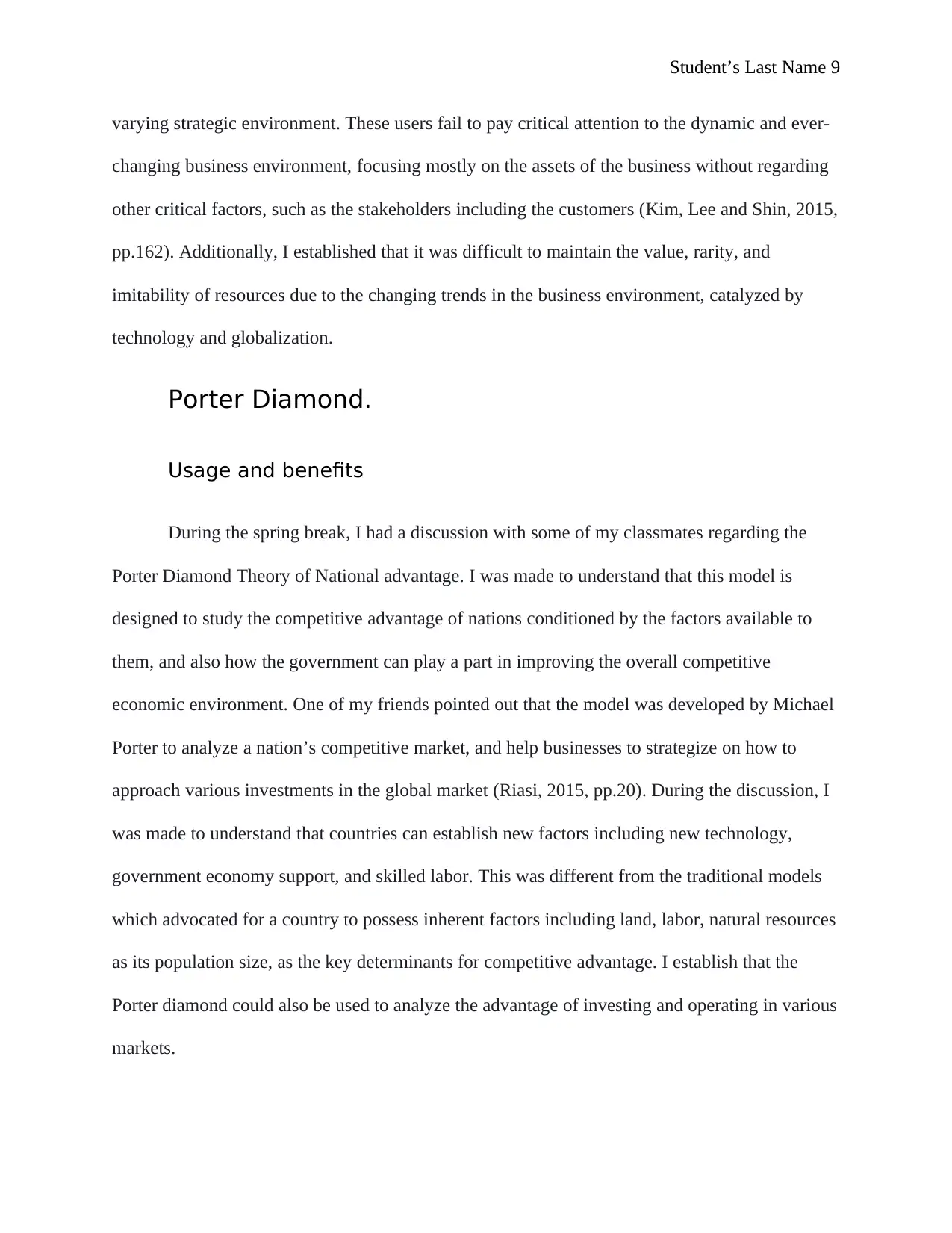
Student’s Last Name 9
varying strategic environment. These users fail to pay critical attention to the dynamic and ever-
changing business environment, focusing mostly on the assets of the business without regarding
other critical factors, such as the stakeholders including the customers (Kim, Lee and Shin, 2015,
pp.162). Additionally, I established that it was difficult to maintain the value, rarity, and
imitability of resources due to the changing trends in the business environment, catalyzed by
technology and globalization.
Porter Diamond.
Usage and benefits
During the spring break, I had a discussion with some of my classmates regarding the
Porter Diamond Theory of National advantage. I was made to understand that this model is
designed to study the competitive advantage of nations conditioned by the factors available to
them, and also how the government can play a part in improving the overall competitive
economic environment. One of my friends pointed out that the model was developed by Michael
Porter to analyze a nation’s competitive market, and help businesses to strategize on how to
approach various investments in the global market (Riasi, 2015, pp.20). During the discussion, I
was made to understand that countries can establish new factors including new technology,
government economy support, and skilled labor. This was different from the traditional models
which advocated for a country to possess inherent factors including land, labor, natural resources
as its population size, as the key determinants for competitive advantage. I establish that the
Porter diamond could also be used to analyze the advantage of investing and operating in various
markets.
varying strategic environment. These users fail to pay critical attention to the dynamic and ever-
changing business environment, focusing mostly on the assets of the business without regarding
other critical factors, such as the stakeholders including the customers (Kim, Lee and Shin, 2015,
pp.162). Additionally, I established that it was difficult to maintain the value, rarity, and
imitability of resources due to the changing trends in the business environment, catalyzed by
technology and globalization.
Porter Diamond.
Usage and benefits
During the spring break, I had a discussion with some of my classmates regarding the
Porter Diamond Theory of National advantage. I was made to understand that this model is
designed to study the competitive advantage of nations conditioned by the factors available to
them, and also how the government can play a part in improving the overall competitive
economic environment. One of my friends pointed out that the model was developed by Michael
Porter to analyze a nation’s competitive market, and help businesses to strategize on how to
approach various investments in the global market (Riasi, 2015, pp.20). During the discussion, I
was made to understand that countries can establish new factors including new technology,
government economy support, and skilled labor. This was different from the traditional models
which advocated for a country to possess inherent factors including land, labor, natural resources
as its population size, as the key determinants for competitive advantage. I establish that the
Porter diamond could also be used to analyze the advantage of investing and operating in various
markets.
⊘ This is a preview!⊘
Do you want full access?
Subscribe today to unlock all pages.

Trusted by 1+ million students worldwide
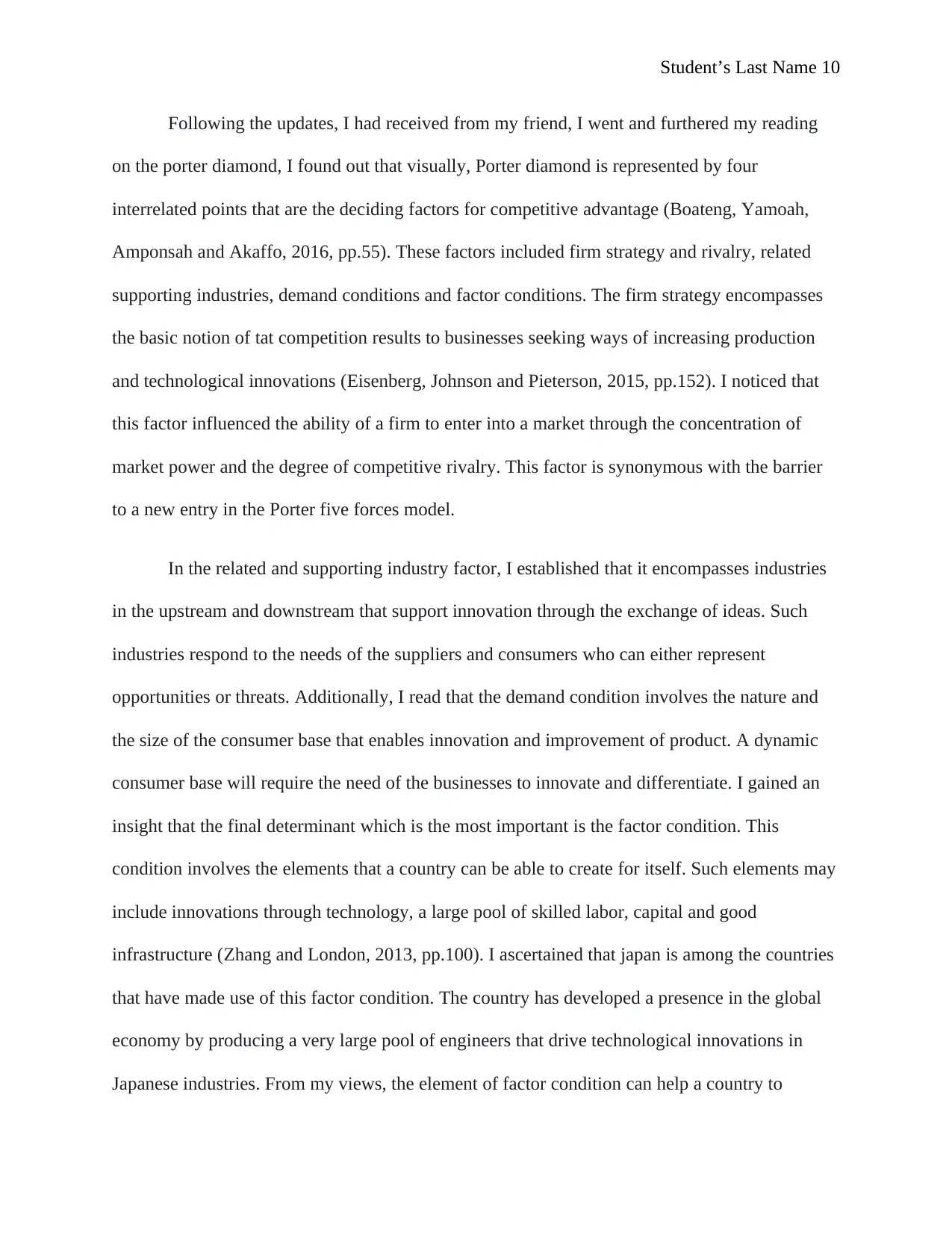
Student’s Last Name 10
Following the updates, I had received from my friend, I went and furthered my reading
on the porter diamond, I found out that visually, Porter diamond is represented by four
interrelated points that are the deciding factors for competitive advantage (Boateng, Yamoah,
Amponsah and Akaffo, 2016, pp.55). These factors included firm strategy and rivalry, related
supporting industries, demand conditions and factor conditions. The firm strategy encompasses
the basic notion of tat competition results to businesses seeking ways of increasing production
and technological innovations (Eisenberg, Johnson and Pieterson, 2015, pp.152). I noticed that
this factor influenced the ability of a firm to enter into a market through the concentration of
market power and the degree of competitive rivalry. This factor is synonymous with the barrier
to a new entry in the Porter five forces model.
In the related and supporting industry factor, I established that it encompasses industries
in the upstream and downstream that support innovation through the exchange of ideas. Such
industries respond to the needs of the suppliers and consumers who can either represent
opportunities or threats. Additionally, I read that the demand condition involves the nature and
the size of the consumer base that enables innovation and improvement of product. A dynamic
consumer base will require the need of the businesses to innovate and differentiate. I gained an
insight that the final determinant which is the most important is the factor condition. This
condition involves the elements that a country can be able to create for itself. Such elements may
include innovations through technology, a large pool of skilled labor, capital and good
infrastructure (Zhang and London, 2013, pp.100). I ascertained that japan is among the countries
that have made use of this factor condition. The country has developed a presence in the global
economy by producing a very large pool of engineers that drive technological innovations in
Japanese industries. From my views, the element of factor condition can help a country to
Following the updates, I had received from my friend, I went and furthered my reading
on the porter diamond, I found out that visually, Porter diamond is represented by four
interrelated points that are the deciding factors for competitive advantage (Boateng, Yamoah,
Amponsah and Akaffo, 2016, pp.55). These factors included firm strategy and rivalry, related
supporting industries, demand conditions and factor conditions. The firm strategy encompasses
the basic notion of tat competition results to businesses seeking ways of increasing production
and technological innovations (Eisenberg, Johnson and Pieterson, 2015, pp.152). I noticed that
this factor influenced the ability of a firm to enter into a market through the concentration of
market power and the degree of competitive rivalry. This factor is synonymous with the barrier
to a new entry in the Porter five forces model.
In the related and supporting industry factor, I established that it encompasses industries
in the upstream and downstream that support innovation through the exchange of ideas. Such
industries respond to the needs of the suppliers and consumers who can either represent
opportunities or threats. Additionally, I read that the demand condition involves the nature and
the size of the consumer base that enables innovation and improvement of product. A dynamic
consumer base will require the need of the businesses to innovate and differentiate. I gained an
insight that the final determinant which is the most important is the factor condition. This
condition involves the elements that a country can be able to create for itself. Such elements may
include innovations through technology, a large pool of skilled labor, capital and good
infrastructure (Zhang and London, 2013, pp.100). I ascertained that japan is among the countries
that have made use of this factor condition. The country has developed a presence in the global
economy by producing a very large pool of engineers that drive technological innovations in
Japanese industries. From my views, the element of factor condition can help a country to
Paraphrase This Document
Need a fresh take? Get an instant paraphrase of this document with our AI Paraphraser
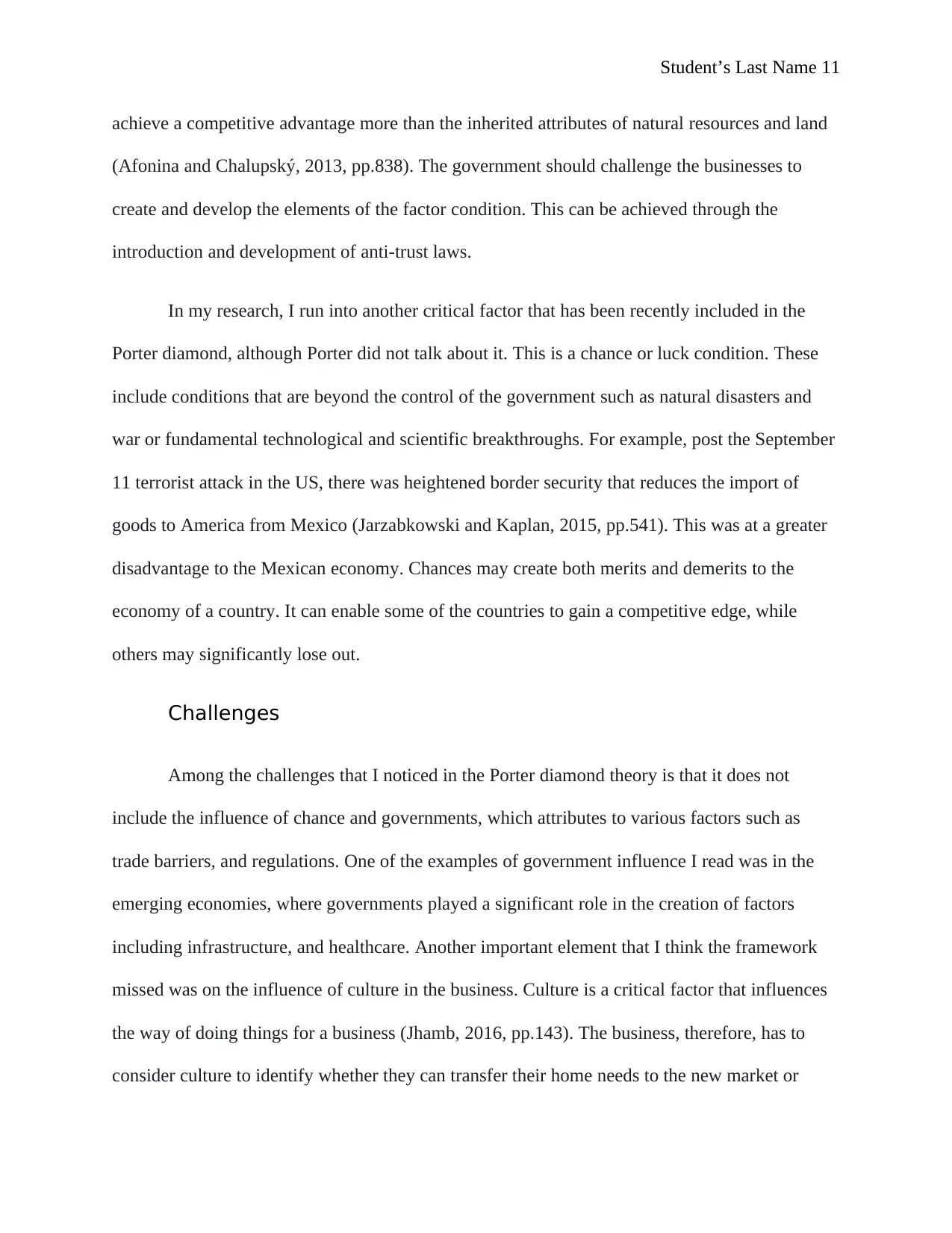
Student’s Last Name 11
achieve a competitive advantage more than the inherited attributes of natural resources and land
(Afonina and Chalupský, 2013, pp.838). The government should challenge the businesses to
create and develop the elements of the factor condition. This can be achieved through the
introduction and development of anti-trust laws.
In my research, I run into another critical factor that has been recently included in the
Porter diamond, although Porter did not talk about it. This is a chance or luck condition. These
include conditions that are beyond the control of the government such as natural disasters and
war or fundamental technological and scientific breakthroughs. For example, post the September
11 terrorist attack in the US, there was heightened border security that reduces the import of
goods to America from Mexico (Jarzabkowski and Kaplan, 2015, pp.541). This was at a greater
disadvantage to the Mexican economy. Chances may create both merits and demerits to the
economy of a country. It can enable some of the countries to gain a competitive edge, while
others may significantly lose out.
Challenges
Among the challenges that I noticed in the Porter diamond theory is that it does not
include the influence of chance and governments, which attributes to various factors such as
trade barriers, and regulations. One of the examples of government influence I read was in the
emerging economies, where governments played a significant role in the creation of factors
including infrastructure, and healthcare. Another important element that I think the framework
missed was on the influence of culture in the business. Culture is a critical factor that influences
the way of doing things for a business (Jhamb, 2016, pp.143). The business, therefore, has to
consider culture to identify whether they can transfer their home needs to the new market or
achieve a competitive advantage more than the inherited attributes of natural resources and land
(Afonina and Chalupský, 2013, pp.838). The government should challenge the businesses to
create and develop the elements of the factor condition. This can be achieved through the
introduction and development of anti-trust laws.
In my research, I run into another critical factor that has been recently included in the
Porter diamond, although Porter did not talk about it. This is a chance or luck condition. These
include conditions that are beyond the control of the government such as natural disasters and
war or fundamental technological and scientific breakthroughs. For example, post the September
11 terrorist attack in the US, there was heightened border security that reduces the import of
goods to America from Mexico (Jarzabkowski and Kaplan, 2015, pp.541). This was at a greater
disadvantage to the Mexican economy. Chances may create both merits and demerits to the
economy of a country. It can enable some of the countries to gain a competitive edge, while
others may significantly lose out.
Challenges
Among the challenges that I noticed in the Porter diamond theory is that it does not
include the influence of chance and governments, which attributes to various factors such as
trade barriers, and regulations. One of the examples of government influence I read was in the
emerging economies, where governments played a significant role in the creation of factors
including infrastructure, and healthcare. Another important element that I think the framework
missed was on the influence of culture in the business. Culture is a critical factor that influences
the way of doing things for a business (Jhamb, 2016, pp.143). The business, therefore, has to
consider culture to identify whether they can transfer their home needs to the new market or
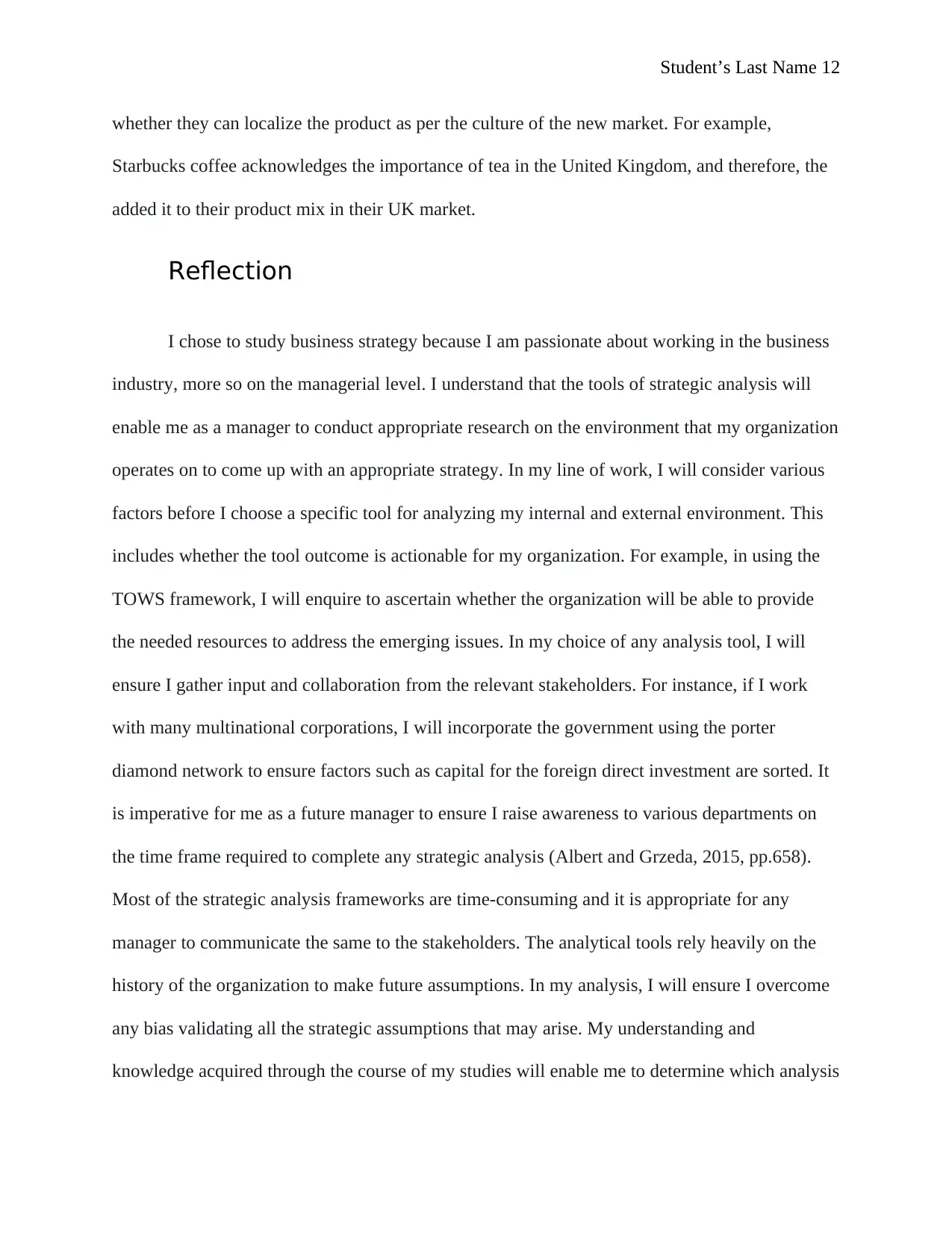
Student’s Last Name 12
whether they can localize the product as per the culture of the new market. For example,
Starbucks coffee acknowledges the importance of tea in the United Kingdom, and therefore, the
added it to their product mix in their UK market.
Reflection
I chose to study business strategy because I am passionate about working in the business
industry, more so on the managerial level. I understand that the tools of strategic analysis will
enable me as a manager to conduct appropriate research on the environment that my organization
operates on to come up with an appropriate strategy. In my line of work, I will consider various
factors before I choose a specific tool for analyzing my internal and external environment. This
includes whether the tool outcome is actionable for my organization. For example, in using the
TOWS framework, I will enquire to ascertain whether the organization will be able to provide
the needed resources to address the emerging issues. In my choice of any analysis tool, I will
ensure I gather input and collaboration from the relevant stakeholders. For instance, if I work
with many multinational corporations, I will incorporate the government using the porter
diamond network to ensure factors such as capital for the foreign direct investment are sorted. It
is imperative for me as a future manager to ensure I raise awareness to various departments on
the time frame required to complete any strategic analysis (Albert and Grzeda, 2015, pp.658).
Most of the strategic analysis frameworks are time-consuming and it is appropriate for any
manager to communicate the same to the stakeholders. The analytical tools rely heavily on the
history of the organization to make future assumptions. In my analysis, I will ensure I overcome
any bias validating all the strategic assumptions that may arise. My understanding and
knowledge acquired through the course of my studies will enable me to determine which analysis
whether they can localize the product as per the culture of the new market. For example,
Starbucks coffee acknowledges the importance of tea in the United Kingdom, and therefore, the
added it to their product mix in their UK market.
Reflection
I chose to study business strategy because I am passionate about working in the business
industry, more so on the managerial level. I understand that the tools of strategic analysis will
enable me as a manager to conduct appropriate research on the environment that my organization
operates on to come up with an appropriate strategy. In my line of work, I will consider various
factors before I choose a specific tool for analyzing my internal and external environment. This
includes whether the tool outcome is actionable for my organization. For example, in using the
TOWS framework, I will enquire to ascertain whether the organization will be able to provide
the needed resources to address the emerging issues. In my choice of any analysis tool, I will
ensure I gather input and collaboration from the relevant stakeholders. For instance, if I work
with many multinational corporations, I will incorporate the government using the porter
diamond network to ensure factors such as capital for the foreign direct investment are sorted. It
is imperative for me as a future manager to ensure I raise awareness to various departments on
the time frame required to complete any strategic analysis (Albert and Grzeda, 2015, pp.658).
Most of the strategic analysis frameworks are time-consuming and it is appropriate for any
manager to communicate the same to the stakeholders. The analytical tools rely heavily on the
history of the organization to make future assumptions. In my analysis, I will ensure I overcome
any bias validating all the strategic assumptions that may arise. My understanding and
knowledge acquired through the course of my studies will enable me to determine which analysis
⊘ This is a preview!⊘
Do you want full access?
Subscribe today to unlock all pages.

Trusted by 1+ million students worldwide
1 out of 16
Related Documents
Your All-in-One AI-Powered Toolkit for Academic Success.
+13062052269
info@desklib.com
Available 24*7 on WhatsApp / Email
![[object Object]](/_next/static/media/star-bottom.7253800d.svg)
Unlock your academic potential
Copyright © 2020–2025 A2Z Services. All Rights Reserved. Developed and managed by ZUCOL.





